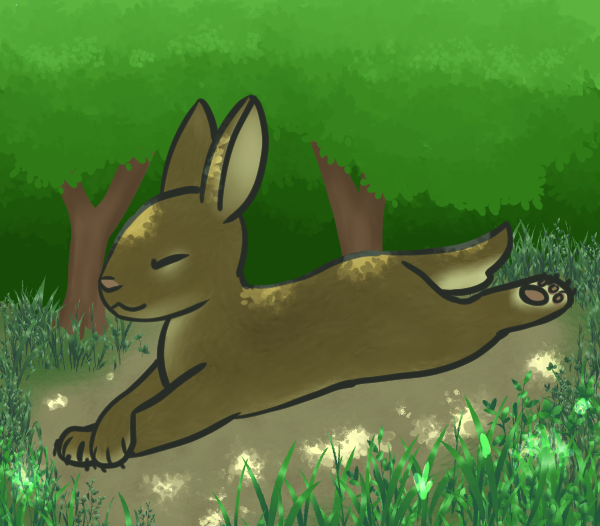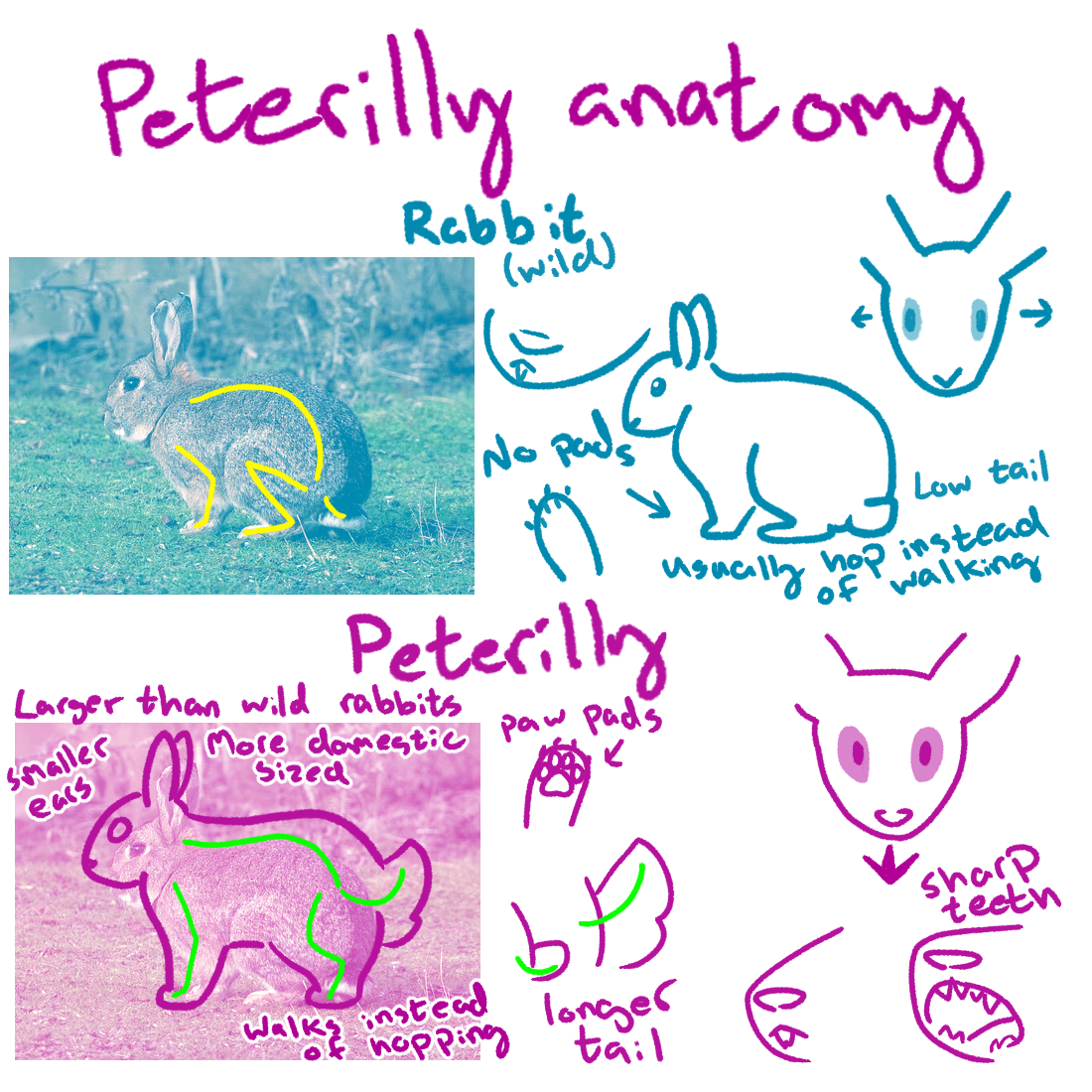Peterillies
Open species | petty ocs can be "unrealistic"! (you can make sparkle petties with wings and emo hair) | anthro or feral
Below is info about realistic feral petties!

Peterillies are small omnivorous woodland animals that look similar to rabbits, but are more closely related to canines. They're roughly the size of a large domestic rabbit, and while they live similarly to normal wild animals, they're very intelligent and show odd, quirky tendencies. They're affectionately referred to as petties, and are known for their audacity and unique hunting style.
Basics
Lifespan: 15 years in the wild, up to 30 in captivity
Diet: Meat, fruit, berries, fungus, fish, stolen human food
Living group size: up to 100
Habitat: Wooded areas ranging from temperate to alpine, often near human settlements
Breeding rate: 3-6 kits twice a year if resources are plentiful
Anatomy

Peterillies are known for their deceptive resemblance to rabbits. Though their bodies are built like a canine's, their chubby shape and thick fur hide the difference in leg and spine structure, and their behavior completes the illusion.
Though they have forward-facing eyes, their skull shape gives the illusion of having outward-facing eyes when viewed from the side. Their ears are slightly shorter than a rabbit's, and their tails slightly longer. They have long canine teeth that sit closer to the front of the mouth, mimicking a rabbit's visible teeth. They have very sharp claws that are semi-retractable and hidden under thick toe fur. A dead giveaway to whether the animal is a rabbit or a peterilly, however, is that peterillies have paw pads where rabbits do not, and they aren't hidden by fur. Peterillies tend to have a coat length similar to rabbits, that appears smooth but is very thick and fluffy.
Peterillies generally have the same fur coloration as wild rabbits, but they can also have fur colors that only usually occur in domestic breeds, like apricot and lilac, as well as markings that also can't be found in wild rabbits. Some have been seen to have markings not found in rabbits at all, like stripes similar to tabby cats' or raccoonlike masks. Peterillies have very complicated color genetics, so it's not uncommon to see all kinds of random colors in one commune, even if many of them are from the same bloodlines - colors can skip generations and markings can spontaneously appear, so it's not uncommon to find litters of kits that are all completely different.

Petties usually have dark eyes, ranging from brown to grey, but occasionally they can also have light brown, gold, or even hazel eyes. White or very pale colored petties have also been seen with red, pink or purple eyes, but this is thought to be a disorder - red-eyed petties prefer to stay in dark places and tend to squint in daylight, so it's believed that they're sensitive to light.
Behavior
Dens
Peterillies are very social animals, living in groups of up to 100 around a central den site called a commune. They often split off into smaller groups of up to 10 to live within the commune's territory, but are still part of the commune. They share dens with up to six others, and decorate these dens and the surrounding walkways with colorful forest things, bits of trash and things that they've woven and built. Petties show distinct color preferences, and often share dens with others who like the same colors, so it can be easy to tell who lives where by the way the den and entrance are decorated. While the entire commune has varied sleep schedules, each den sleeps, has meals, hunts and grooms together. In larger communes, there will be activity all hours of the day. When resources are scarce, groups will often split off to go find a less populated area to live, and when resources are plentiful, several mated pairs will leave together to go start a new commune if theirs has reached full capacity. While they tend to stick to their own territory, communes don't usually have bad blood between each other, so it's not uncommon to see small temporary dens from one commune in another's territory. When meeting petties from another commune, the two groups will thoroughly inspect each other, but rarely fight - in fact, sometimes traveling groups will be allowed to stay at the den sites belonging to the commune whose territory they're passing through, and struggling strays will often be accepted into communes with resources to spare.
Noises
Petties communicate with each other through barks, yips, chirps and howls that are more musical than that of other howling animals. Each peterilly has a howl tune unique to itself, which they use to locate each other or check in while traveling. However, around other animals, they often opt to not make a sound - they tend to be very quiet around wild animals, however, domestic petties also become very chatty if they choose to live in households, and will vocalize with other animals. They are capable of imitating a lot of animal sounds, and if they frequently encounter people, they can even learn to say human words.
Animals
Peterillies can get along with any kind of animal if it suits their needs. They take full advantage of their resemblance to rabbits in order to look like a harmless herbivore, so they often interact with prey animals like deer just as easily as they do with other predators. They cooperate better with more intelligent animals, and are often seen hunting together with corvids, coyotes, foxes and even feral dogs and cats. Because they can imtiate other animal sounds, they often use this to their advantage to either scare or lure other animals.
Hunting
There are many techniques petties use for hunting, depending on what they've chosed to hunt. They usually hunt in groups, and for herbivorous prey, they pretend to be rabbits in order to get close to prey animals before striking. They will go after animals as big as sheep on their own, but the entire group will turn their efforts to a single target if it's bigger - large groups of peterillies have even been knows to take down large, healthy deer. They will use this same technique to hunt things that prey on rabbits, one of the group acting as bait while the others hide and strike when a predator tries to attack their decoy. They also have been known to fish, snagging them with their claws, or climb trees to steal eggs, pick fruit or drop down on things when hunting alone.
Rabbits
Rabbits are peterillies' primary food source, and are treated differently than other animals. Petties will spend time socializing with the rabbits in their area, gaining their trust, and often helping them survive; they're a bane on other animals who eat rabbits, as they'll also eat the competition gladly to keep their colony of rabbits healthy. As a result, they're usually far healthier and in far greater numbers than rabbit colonies living outside peterilly territory. As they don't want to scare them, peterillies will "hunt" by hanging out with a target rabbit until it either wanders away on its own, or they can lead it away to kill it without scaring the others; however, most of the time, they're only there to socialize. Oftentimes, a rabbit colony will become so used to a peterilly that they can lower their disguise a bit - To imitate a rabbit, they'll hop instead of walking, keep their mouths closed, and only look at things from the side, but a petty surrounded by rabbits that know it well will often walk normally or groom themselves or the rabbits without worry of showing their teeth. They will not, however, stop looking at them from the side, as looking at them directly has been observed to startle rabbits no matter how familiar they are with the petty.
Crafting
Peterillies are capable of making simple weaves and knots, so they adorn themselves with jewelry made from grasses, plants and garbage. They also make some simple tools, like baskets and cords, and decorate their communes with woven fences and stacked and tied sticks to form surprisingly ornate structures. Each commune has its own style of decorating, so observers can use the architecture to determine which den site belongs to which commune in areas where territories overlap. They adore human items, especially things that are shiny, glittery or colorful, and will steal anything not nailed down if they think it's neat; from beads to wrappers to toys to jewelry right off people's wrists, they like taking colorful, flashy things and nibbling holes in them to add them to their accessories and decor. They also love fake flowers, especially ones that resemble local flora, and will wear them instead of real flowers that dry up. They wear a lot of accessories, usually around the neck and legs, making it even easier to tell individuals apart.
Humans and pets
Peterillies living in human-populated areas are a common sight in places near where the forest meets the town. They won't stray very far into urban sprawl, but will happily visit backyards, parks and other areas close to the wilderness. They like to play with pets and children, some even visiting parks or playgrounds often enough that they're mistaken for pets themselves. They also have a taste for strong flavors, and will mooch or steal human food whenever they get the chance, even using their rabbit performance to do so. They tend to prefer salty or savory snack foods and strongly flavored candy, but will accept anything offered to them. Because of their very social nature and ability to wear jewelry, their trust can easily be bought with things they can wear, like small hats or scarves or necklaces that they can put on by themselves. They've also been known to appreciate coats or baby socks with the toes removed, and wear them when the weather is appropriate. Wild petties are very curious, so you may not be safe even in your own home; they've been known to poke their heads in through doors left open, sit on the sills of open windows, or even peep in from nearby rooftops to watch what's going on inside. The less snooping-inclined will often venture into human areas to look for things to steal, with a preference for food and items they can decorate their dens with. They will even steal plants from gardens to plant themselves in their territory, but they may plant the wrong parts of what they steal if it's something not native to the area.
As pets
Peterillies can occasionally decide that they like a human enough to adopt them, following them home or simply walking in and refusing to leave, or be brought home by a pet allowed to wander who has befriended them. When they come into the home by choice, they make excellent pets; they are very family oriented, and fiercely protective, to the point of viciously mauling burglars or hunting down and killing predators threatening pets or livestock. They are capable of learning to speak simple phrases, and even picking their own names, making them very easy to train and care for - it's commonplace for them to simply tell their owner what they want, or even have simple conversations and be reasoned with. It's very common for them to look after the other animals in a household, removing or scolding them away from hazards. However, despite being excellent pets, their intelligence also makes them a nightmare if they don't want to be kept; they hold onto grudges for a long time, and capturing a petty will not only end in the destruction of one's house, but ripped up flowerbeds and scattered trash cans for weeks or even months afterwards once they escape. Some stories even tell of petties learning how to mess with outdoor fuse boxes and waking up residents with horrible, humanlike screams should they leave windows open at night. When being taken in to treat injuries or provide shelter from storms, they tend to be apprehensive, but tolerate the assistance only as long as they need it; offering help to a peterilly will often result in them coming by to visit if their experience was positive.
Peterilly groves
Forests that are home to sizeable communes often end up taking on magical properties. It's unknown whether the magical properties are a result of the commune's presence, or if the communes are there because of the magic. These groves are laden with odd plant life, trees becoming so thick that the forest is far darker than normal and unknown, unidentifiable plants appearing. These dark places are also the source of a strange mineral that, when nipped by a peterilly's teeth, can make sparks capable of setting oddly-colored, cool fires. These fires are used to light commune den sites and pathways, as the dark forests are SO dark that even animals have trouble navigating them. Peterillies can see better than most animals in this magical darkness, and ruby-eyed peterillies even better still, but some carry lanterns made of sticks. it's unknown how the fire doesn't spread, but it seems to only stay where the sparks land. In these magical forests, an odd phenomenon can be observed in the rabbits as well; when a rabbit has slighted one of its colony, there are disputes between bucks, or a rabbit is too weak or disabled to survive in the wild, they will be chased into the darker parts of the grove. The longer these rabbits live in the darkness, the more they change - often guided by the lights from the communes, most will find their way to peterilly settlements, to be taken in by the petties. Eventually, they are indistinguishable from real peterillies by any means other than DNA testing. These changed rabbits will adopt most peterilly behavior and physical features - even growing to the correct size - however, they've been noted to lack the interest in colors or crafting that peterillies are known for. They're even capable of breeding with real petties, something normal rabbits can't do, and any kits will be genetically 100% peterilly if tested.
These groves are not very large, and most communes will have plenty of territory and den sites outside the reaches of the darker forest. Other animals often pass through, but often follow the lights from the paths and lanterns to navigate.
 Species
Species